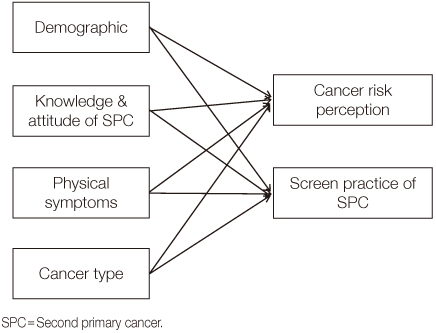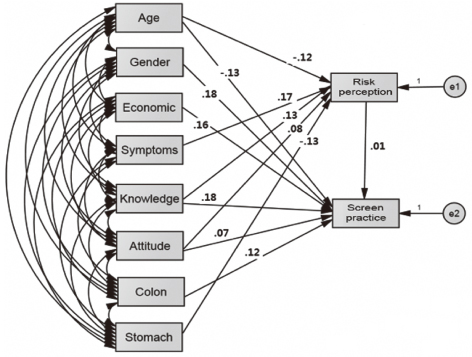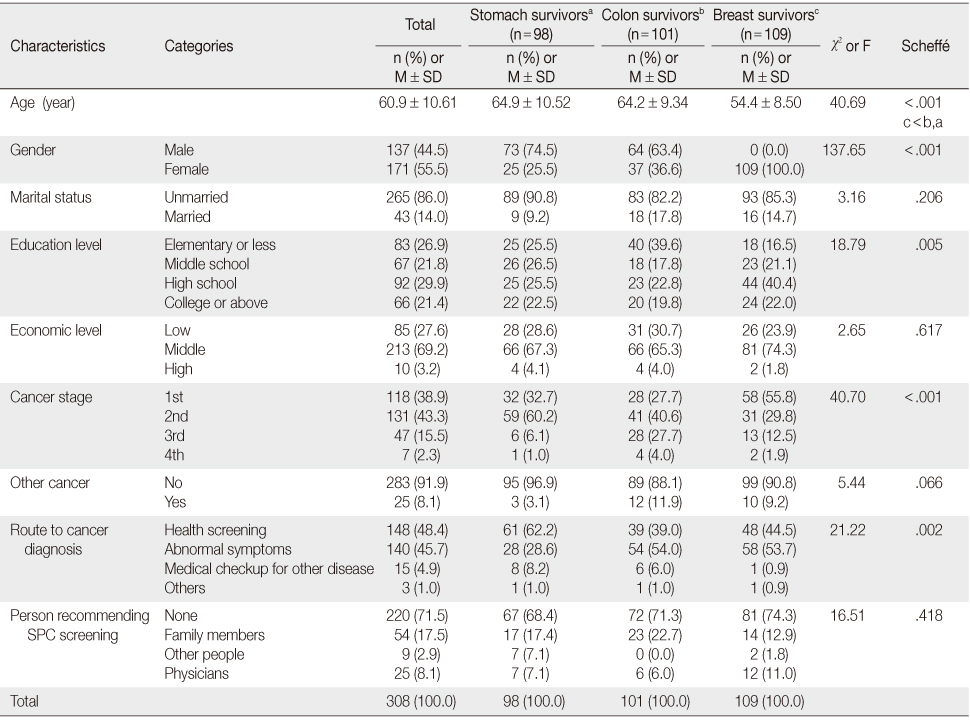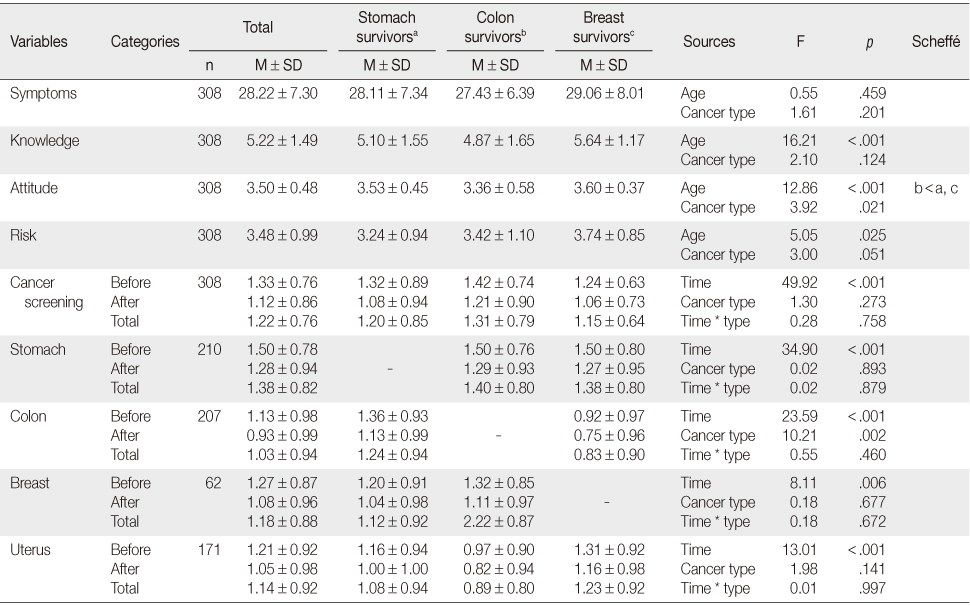Articles
- Page Path
- HOME > J Korean Acad Nurs > Volume 44(2); 2014 > Article
-
Original Article
- A Path Analysis on Factors Influencing Second Primary Cancer Screening Practices in Stomach, Colon, and Breast Cancer Survivors
- Young Hee Yang
-
Journal of Korean Academy of Nursing 2014;44(2):139-148.
DOI: https://doi.org/10.4040/jkan.2014.44.2.139
Published online: April 30, 2014
Department of Nursing, Dankook University, Cheonan, Korea.
- Address reprint requests to: Yang, Young Hee. Department of Nursing, Dankook University, 119 Dandae-ro, Dongnam-gu, Cheonan 330-714, Korea. Tel: +82-41-550-3881, Fax: +82-41-559-7902, hanul96@dankook.ac.kr
© 2014 Korean Society of Nursing Science
This is an Open Access article distributed under the terms of the Creative Commons Attribution NoDerivs License. (http://creativecommons.org/licenses/by-nd/4.0/) If the original work is properly cited and retained without any modification or reproduction, it can be used and re-distributed in any format and medium.
Abstract
-
Purpose
- This study was conducted to identify the factors influencing second primary cancer (SPC) screening practice by examining the relationships of physical symptoms, knowledge and attitudes regarding SPC screening, perceived risk, primary cancer type, and demographic factors of cancer survivors.
-
Methods
- Participants were 308 survivors of stomach, colon, or breast cancer recruited from 2 university hospitals in Korea. Data were collected using a questionnaire and analyzed using IBM SPSS 21.0 and AMOS 18.0.
-
Results
- The proportion of participants taking all cancer screenings according to national guidelines was 40%. They had moderate knowledge and a relatively positive attitude regarding SPC screening and high cancer risk perception. The participants had taken fewer SPC screenings after than before cancer diagnosis. The factors influencing cancer risk perception were age, physical symptoms, knowledge regarding SPC and primary cancer type (stomach). The factors influencing SPC screening practice were age, gender, economic status, knowledge regarding SPC screening, and primary cancer types (colon).
-
Conclusion
- It is important for clinical professionals to recognize that survivors of cancer are susceptible to another cancer. Education on SPC screening for these survivors should focus on communicating with and encouraging them to have regular cancer screenings.
- 1. Feuerstein M. Defining cancer survivorship. J Cancer Surviv. 2007;1(1):5–7. http://dx.doi.org/10.1007/s11764-006-0002-xArticlePubMedPDF
- 2. National Cancer Center. National cancer control programs [Internet]. Goyang, National Cancer Center. 2013;cited 2013 November 3. Available from: http://www.ncc.re.kr/manage/manage12_00.jsp
- 3. Carver JR, Shapiro CL, Ng A, Jacobs L, Schwartz C, Virgo KS, et al. American Society of Clinical Oncology clinical evidence review on the ongoing care of adult cancer survivors: Cardiac and pulmonary late effects. J Clin Oncol. 2007;25(25):3991–4008. http://dx.doi.org/10.1200/jco.2007.10.9777ArticlePubMed
- 4. Wilkins KL, Woodgate RL. Preventing second cancers in cancer survivors. Oncol Nurs Forum. 2008;35(2):E12–E22. http://dx.doi.org/10.1188/08.onf.e12-e22ArticlePubMed
- 5. Cho J, Guallar E, Hsu YJ, Shin DW, Lee WC. A comparison of cancer screening practices in cancer survivors and in the general population: The Korean national health and nutrition examination survey (KNHANES) 2001-2007. Cancer Causes Control. 2010;21(12):2203–2212. http://dx.doi.org/10.1007/s10552-010-9640-4ArticlePubMedPDF
- 6. Travis LB. The epidemiology of second primary cancers. Cancer Epidemiol Biomarkers Prev. 2006;15(11):2020–2026. http://dx.doi.org/10.1158/1055-9965.epi-06-0414ArticlePubMedPDF
- 7. Mariotto AB, Rowland JH, Ries LA, Scoppa S, Feuer EJ. Multiple cancer prevalence: A growing challenge in long-term survivorship. Cancer Epidemiol Biomarkers Prev. 2007;16(3):566–571. http://dx.doi.org/10.1158/1055-9965.epi-06-0782ArticlePubMedPDF
- 8. Park SM, Lim MK, Jung KW, Shin SA, Yoo KY, Yun YH, et al. Prediagnosis smoking, obesity, insulin resistance, and second primary cancer risk in male cancer survivors: National Health Insurance Corporation Study. J Clin Oncol. 2007;25(30):4835–4843. http://dx.doi.org/10.1200/jco.2006.10.3416ArticlePubMed
- 9. Trask PC, Rabin C, Rogers ML, Whiteley J, Nash J, Frierson G, et al. Cancer screening practices among cancer survivors. Am J Prev Med. 2005;28(4):351–356. http://dx.doi.org/10.1016/j.amepre.2005.01.005ArticlePubMed
- 10. Park JK, Park HA. Screening rates of major cancers after a cancer diagnosis in adults in Korea. Korean J Health Promot. 2012;12(2):67–74.
- 11. Shin DW, Baik YJ, Kim YW, Oh JH, Chung KW, Kim SW, et al. Knowledge, attitudes, and practice on second primary cancer screening among cancer survivors: A qualitative study. Patient Educ Couns. 2011;85(1):74–78. http://dx.doi.org/10.1016/j.pec.2010.09.015ArticlePubMed
- 12. Shin DW, Kim YW, Oh JH, Kim SW, Chung KW, Lee WY, et al. Knowledge, attitudes, risk perception, and cancer screening behaviors among cancer survivors. Cancer. 2011;117(16):3850–3859. http://dx.doi.org/10.1002/cncr.25951ArticlePubMed
- 13. Cox CL. Online exclusive: A model of health behavior to guide studies of childhood cancer survivors. Oncol Nurs Forum. 2003;30(5):E92–E99. http://dx.doi.org/10.1188/03.onf.e92-e99PubMed
- 14. Rimal RN, Juon HS. Use of the risk perception attitude framework for promoting breast cancer prevention. J Appl Soc Psychol. 2010;40(2):287–310. http://dx.doi.org/10.1111/j.1559-1816.2009.00574.xArticle
- 15. Katapodi MC, Lee KA, Facione NC, Dodd MJ. Predictors of perceived breast cancer risk and the relation between perceived risk and breast cancer screening: A meta-analytic review. Prev Med. 2004;38(4):388–402. http://dx.doi.org/10.1016/j.ypmed.2003.11.012ArticlePubMed
- 16. Oh EJ, Lee YE, Lee SO. Cervical cancer screening behavior and related factors among married women. J Korean Soc Matern Child Health. 2010;14(1):12–23.Article
- 17. Yang YH. Relationships between knowledge about early detection, cancer risk perception and cancer screening tests in the general public aged 40 and over. Asian Oncol Nurs. 2012;12(1):52–60. http://dx.doi.org/10.5388/aon.2012.12.1.52ArticlePDF
- 18. Ju HO, Kim JS, Cho YS, Park NH, Eo YS, Cho YR, et al. A survey on cancer screening among nurses at general hospital in Busan. Korean J Women Health Nurs. 2003;9(1):18–27.ArticlePDF
- 19. Hwang SK, Eo YS, Cho YR, Seo JM, Lee YM, Jeong IS, et al. A survey on cancer screening among the middle-aged in Pusan area. J Korean Soc Health Educ Promot. 2002;19(3):135–152.
- 20. Khan NF, Carpenter L, Watson E, Rose PW. Cancer screening and preventative care among long-term cancer survivors in the United Kingdom. Br J Cancer. 2010;102(7):1085–1090. http://dx.doi.org/10.1038/sj.bjc.6605609ArticlePubMedPMCPDF
- 21. Kelly KM, Shedlosky-Shoemaker R, Porter K, Desimone P, Andrykowski M. Cancer recurrence worry, risk perception, and informational-coping styles among appalachian cancer survivors. J Psychosoc Oncol. 2011;29(1):1–18. http://dx.doi.org/10.1080/07347332.2011.534014ArticlePubMedPMC
- 22. Shin DW, Kim Y, Baek YJ, Mo HN, Choi JY, Cho J. Oncologists experience with second primary cancer screening: Current practices and barriers and potential solutions. Asian Pac J Cancer Prev. 2012;13(2):671–676.ArticlePubMed
- 23. Park ER, Ostroff JS, Rakowski W, Gareen IF, Diefenbach MA, Feibelmann S, et al. Risk perceptions among participants undergoing lung cancer screening: Baseline results from the national lung screening trial. Ann Behav Med. 2009;37(3):268–279. http://dx.doi.org/10.1007/s12160-009-9112-9ArticlePubMed
- 24. Park SM, Park CT, Park SY, Bae DS, Nam JH, Cho CH, et al. Factors related to second cancer screening practice in disease-free cervical cancer survivors. Cancer Causes Control. 2009;20(9):1697–1703. http://dx.doi.org/10.1007/s10552-009-9421-0ArticlePubMedPDF
- 25. Bae BR. LISREL structural equation model: Understanding, application and programming. 2nd ed. Seoul: Chungram Books; 2008.
- 26. Stein KD, Denniston M, Baker F, Dent M, Hann DM, Bushhouse S, et al. Validation of a modified Rotterdam symptom checklist for use with cancer patients in the United States. J Pain Symptom Manage. 2003;26(5):975–989.ArticlePubMed
- 27. Kim SE, Pérez-Stable EJ, Wong S, Gregorich S, Sawaya GF, Walsh JM, et al. Association between cancer risk perception and screening behavior among diverse women. Arch Intern Med. 2008;168(7):728–734. http://dx.doi.org/10.1001/archinte.168.7.728ArticlePubMedPMC
REFERENCES
Figure & Data
REFERENCES
Citations

- Development of Integrated Supportive Care Nursing Competence Scale for Cancer Survivors
Eun-Jung Bae, Yun-Hee Kim
Healthcare.2024; 12(7): 755. CrossRef - Health Behaviors of Cancer Survivors According to the Employment Status and Occupation: A Cross-Sectional Study
Ka Ryeong Bae, Wi-Young So, Su Jung Lee
Healthcare.2023; 11(22): 2974. CrossRef - Survivors’ health competence mediates the association between wearable activity tracker use and self-rated health: HINTS analysis
Steven De La Torre, Donna Spruijt-Metz, Albert J. Farias
Journal of Cancer Survivorship.2022; 16(6): 1268. CrossRef - Factors Associated with Health Check-up and Cancer Screening Participation among Family Caregivers of Patients with Dementia: A Cross-Sectional Study
Bomgyeol Kim, Yejin Lee, Jin-Won Noh, Tae Hyun Kim
BMC Public Health.2021;[Epub] CrossRef - Factors Influencing Supportive Care Needs of Colorectal Cancer Survivors
Hyekyung Kim, Yang-Sook Yoo
Asian Nursing Research.2021; 15(1): 60. CrossRef - Factors Influencing Quality of Life among Cancer Survivors: Based on the Korean National Health and Nutrition Examination Survey (KNHANES) for 2019
Hee Jung Kim
The Korean Journal of Rehabilitation Nursing.2021; 24(2): 109. CrossRef - Colorectal cancer screening practices among cancer survivors five years after diagnosis
Adeline Monet, Rajae Touzani, Anne-Déborah Bouhnik, Marc-Karim Bendiane, Julien Mancini
Journal of Public Health.2021; 29(4): 805. CrossRef - An Integrated TK-TD Model for Evaluation of Radix Aconitikusnezoffii (RAK)
Xin Miao, Ren Bu, Yang Liu, Bing Li, Xiaofei Zhang, Haiyan Xing, Gang Li
Pharmacology.2020; 105(11-12): 669. CrossRef - A Comparative Study on the Characteristics of Cancer Patients and Cancer Survivors
So Young Baek, Ja Yun Choi
Asian Oncology Nursing.2018; 18(1): 11. CrossRef - Breast and Cervical Cancer Screening Behavior in Female Cancer Survivors: The Korea National Health and Nutrition Examination Survey, 2007–2012
Eun-Ae Lee, Jinyoung Shin, Eun-Joo Hwang, Jung-Woong Lee
Korean Journal of Family Medicine.2017; 38(3): 116. CrossRef - The necessity of analysis of cancer survivor concept in Korea
Jiyoung Kim
Journal of Comprehensive Nursing Research and Care.2017;[Epub] CrossRef - The Factors Related to the Non-Practice of Cancer Screening in Cancer Survivors: Based on the 2007-2012 Korean National Health and Nutrition Examination Survey
Song-Ei Yang, Nam-Kyung Han, Sun-Mi Lee, Tae-Hyun Kim, Woojin Chung
Health Policy and Management.2015; 25(3): 162. CrossRef


Figure 1
Figure 2
General Characteristics of Participants (N=308)
SPC=Second primary cancer.
Differences in Measured Variables according to Cancer Type (N=308)
Path Coefficients for Second Primary Cancer Screening Practices
*Dummy variables: Breast cancer is a reference value; †Dummy variable: Male is a reference value; CR=Critical ratio; SMC=Squared multiple correlations.
SPC=Second primary cancer.
*Dummy variables: Breast cancer is a reference value; †Dummy variable: Male is a reference value; CR=Critical ratio; SMC=Squared multiple correlations.
 KSNS
KSNS
 E-SUBMISSION
E-SUBMISSION





 Cite
Cite

